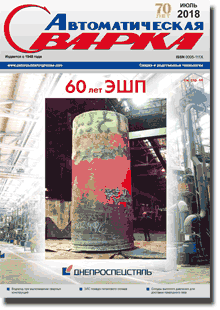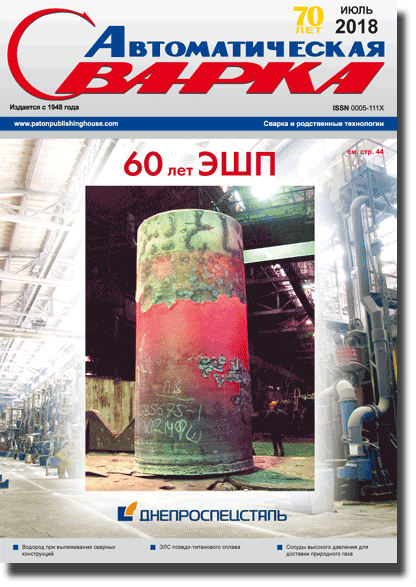| 2018 №07 (05) |
DOI of Article 10.15407/as2018.07.06 |
2018 №07 (07) |

Avtomaticheskaya Svarka (Automatic Welding), # 7, 2018, pp. 37-40
Calculation of penetration zone dimensions in surfacing of rolls of machines for continuous casting of billets
V.N. Matvienko, L.K. Leshchinsky, V.A. Mazur
State Higher Eductation Instittue Pryazovskyi State Technical University 7 Universitetskaya Str., 87500, Mariupil, Ukraine. Е-mail: matviyenkovn@gmail.com
It is shown that in surfacing of rolls in machines for continuous casting of billets (MCCB) the dimensions of penetration zone are affected by chemical composition and thermal physical properties of the material of roller or deposited sublayer. The calculated values of cross-sectional area, penetration depth and volume of the molten metal are presented obtained by numerical modeling on the basis of the solution of the nonlinear three-dimensional differential equation of thermal conductivity, taking into account the approximated temperature dependence of thermal conductivity coefficient. It was established by calculation and confirmed by experiment that the dimensions of penetration zone increase in surfacing by strip electrode under flux on a sublayer of martensitic-ferrite high-chromium steel and in a higher extent on a sublayer of austenitic chromium-nickel steel as compared to surfacing on the material, or on a sublayer of low-carbon low-alloyed steel. 10 Ref., 3 Tab., 3 Fig.
Keywords: roll of machine for continuous casting of billets, base metal, submerged surfacing, strip electrode, penetration zone, dimensions, numerical simulation, deposited layer, sublayer, chemical composition, thermophysical characteristics, thermal conductivity coefficient
Received: 14.05.2018
Published: 19.06.2018
References 1. Ryabtsev, I.A., Babinets, A.A., Ryabtsev, I.I. (2011) Effect of sub-layer on heat resistance of multilayer deposited metal. The Paton Welding J., 10, 18–21.
2. Ryabtsev, I.A., Senchenkov, I.K. (2013) Theory and practice of surfacing operations. Kiev, Ekotekhnologiya [in Russian].
3. Kirchu, I.F., Stepanova, T.V., Suprun, M.V. (2015) Prospects of application of steel with nitrovanadium hardening for rolls of slab BCCM instead of steel 25Kh1M1F. Metall i Litio Ukrainy, 1, 18–22 [in Russian].
4. Dombrovsky, F.S., Leshchinsky, L.K. (1995) Operability of surfaced rolls of billet continuous casting machines. Kiev, PWI [in Russian].
5. (2014) Cored wires for cladding and thermal metal spraying. Welding Alloys Group.
6. Mills, K.C. (2002) Recommended values of thermophysical properties for selected commercial alloys. England, Cambridge, Woodhead Publishing. https://doi.org/10.1533/9781845690144
7. Peet, M.J., Hasan, H.S., Bhadeshia, H.K. (2011) Prediction of thermal conductivity of steel. J. of Heat and Mass, 54, 2602–2616. https://doi.org/10.1016/j.ijheatmasstransfer.2011.01.025
8. Matvienko, V.N., Mazur, V.A., Leshchinsky, L.K. (2015) Evaluation of shape and sizes of weld pool in surfacing using combined strip electrode. The Paton Welding J., 9, 28–31. https://doi.org/10.15407/tpwj2015.09.04
9. Mazur, V.A., Leshchinsky, L.K., Matvienko, V.N. (2018) Influence of thermophysical properties of base metal on geometry of penetration zone in strip electrode surfacing. Proizvodstvo, 3, 10–14 [in Russian].
10. Matvienko, L.K., Mazur, V.O. (2017) Method of surfacing of rolls of continuous casting machines. 116526, Ukraine, Int. Cl. B23K 9/04 [in Ukrainian].
The cost of subscription/purchase order journals or individual articles
| Journal/Currency | Annual Set | 1 issue printed |
1 issue |
one article |
| TPWJ/USD | 384 $ | 32 $ | 26 $ | 13 $ |
| TPWJ/EUR | 348 € | 29 € | 24 € | 12 € |
| TPWJ/UAH | 7200 UAH | 600 UAH | 600 UAH | 280 UAH |
| AS/UAH | 1800 UAH | 300 UAH | 300 UAH | 150 UAH |
| AS/USD | 192 $ | 32 $ | 26 $ | 13 $ |
| AS/EUR | 180 € | 30 € | 25 € | 12 € |
| SEM/UAH | 1200 UAH | 300 UAH | 300 UAH | 150 UAH |
| SEM/USD | 128 $ | 32 $ | 26 $ | 13 $ |
| SEM/EUR | 120 € | 30 € | 25 € | 12 € |
| TDNK/UAH | 1200 UAH | 300 UAH | 300 UAH | 150 UAH |
| TDNK/USD | 128 $ | 32 $ | 26 $ | 13 $ |
| TDNK/EUR | 120 € | 30 € | 25 € | 15 € |
AS = «Automatic Welding» - 6 issues per year;
TPWJ = «PATON WELDING JOURNAL» - 12 issues per year;
SEM = «Electrometallurgy Today» - 4 issues per year;
TDNK = «Technical Diagnostics and Non-Destructive Testing» - 4 issues per year.





